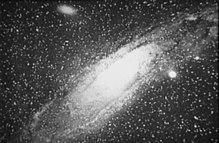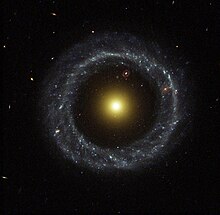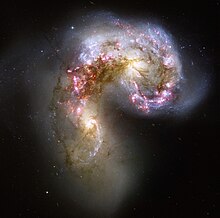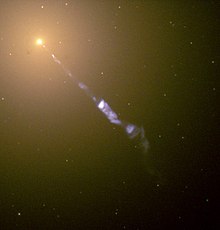గేలక్సీ



గేలక్సీ (ఆంగ్లం : Galaxy) ఓ ఘనమైన గురుత్వాకర్షక వర్తుల విధానం, ఇందులో కోటానుకోట్ల నక్షత్రాలు, అంతర్ నక్షత్ర యానకం ఐన వాయువు, అంతరిక్ష ధూళి, చీకటి పదార్థం గలవు.[2][3] గేలక్సీ అనే పేరుకు మూలం గ్రీకు భాష పదం 'గేలక్సియాస్' [γαλαξίας], అర్థం "పాలతోకూడిన" గేలక్సీ, (పాలపుంతలో లాగ). ఈ గేలక్సీల పరిధి మరుగుజ్జు వీటిలో కనీసం ఓ కోటి నక్షత్రాల [4] (107) నుండి రాకాసులు వెయ్యికోట్ల నక్షత్రాలను కలిగి వుంటాయి.[5] (1012) ఈ నక్షత్రాలన్నీ ఓ అత్యధిక గరిమ గల కేంద్రకం చుట్టూ పరిభ్రమిస్తూ వుంటాయి. ఈ గేలక్సీలలో నక్షత్ర కుటుంబాలూ వుంటాయి, నక్షత్ర కూటమి, అనేక అంతర్ నక్షత్ర మేఘాలు వుంటాయి. మన సూర్యుడు, పాలపుంత గేలక్సీ లోని ఒక నక్షత్రం; మన సౌర కుటుంబంలో భూమి, ఇతర గ్రహాలు సూర్యుని చుట్టూ పరి భ్రమిస్తూ ఉంటాయి.
చారిత్రకంగా గేలక్సీలు తమ ఆకారాన్ని బట్టి గుర్తింపబడ్డాయి. వాటి ఆకారాలు శాస్త్రీయంగా, క్రింది విధంగా గుర్తింప బడ్డాయి :
- వర్తులాకార గేలక్సీలు, ఇవి వర్తులాకారంలో వుంటాయి.[6]
- సర్పిలాకార గేలక్సీలు, ఇవి సర్పిలాకారంలో వుంటాయి.
- అనాకార గేలక్సీలు లేదా ప్రత్యేక గేలక్సీలు, వీటికి ప్రత్యేకమైన ఆకారమంటూ వుండదు. వీటిలో 'నక్షత్రాల పుట్టుక'కు ఆస్కారమెక్కువ. దాదాపు గేలక్సీలు 1,000 నుండి 100,000 పార్సెక్లు గల వ్యాసం గలిగి వుంటాయి.[5], మిలియన్ల పార్సెక్కుల దూరాలనూ గలిగి వుంటాయి.[7] అంతర్ గేలక్సీ అంతరాళం (Intergalactic space) లేదా గేలక్సీలకు మధ్య దూరం, సాధారణంగా వాయువు, సరాసరి సాంద్రత, ఒక ఘనపు మీటరుకు ఒక అణువుతో నింపబడివుంటుంది.[8] సాధారంగా గేలక్సీల 90% గరిమ చీకటి పదార్థంతో నింపబడివుంటుందని భావిస్తాం. శాస్త్రవేత్తల వీక్షణాల ఆధారంగా ఇంకనూ భావించడమేమంటే, ఈ గేలక్సీలకు మధ్య కాలబిలం లేదా బ్లాక్ హోల్లు వుండవచ్చునని.[9]
నామ రూపాలు
[మార్చు]
గేలక్సీ, గ్రీకు పదంనుండి పుట్టినది. అంతరిక్ష సాహిత్యంలో 'గేలక్సీ' అనే పదము, మనముంటున్న పాలపుంత గేలక్సీ కొరకు ఉపయోగిస్తారు.[10]
వీక్షణ చరిత
[మార్చు]మనముంటున్న గేలక్సీ, లేదా పాలపుంత గేలక్సీని శాస్త్రవేత్తలు, వీక్షకులూ, క్షుణ్ణంగా అనేక యుగాలుగా వీక్షిస్తూ నిర్దిష్టమైన సమాచారాన్ని క్రోడీకరించారు. వీటికి శాస్త్రీయ నామాలు పెట్టారు.
పాలపుంత
[మార్చు].

విలియం హెర్షెల్, మొదటి సారిగా పాలపుంత గురించి విపులంగా వర్ణించాడు. మనం నివసిస్తున్న సౌరకుటుంబం లేదా సౌరమండలము, దీని మధ్యలో వున్నట్టుగా అభివర్ణించాడు.[11][12]

18వ శతాబ్దపు ఆఖరులో, చార్లెస్ మెస్సియర్, 109 కాంతివంతమైన నెబ్యూలాల జాబితా తయారు చేశాడు. తరువాత విలియమ్ హెర్షెల్ చే 5,000 నెబ్యూలాల జాబితా తయారు చేశాడు.[13] 1845 లో, లార్డ్ రాస్సె, ఓ కొత్త దూరదర్శిని (టెలిస్కోప్) ను తయారుచేసి, వర్తులాకార, సర్పిలాకార నెబ్యూలాల మధ్య తేడాలు తెలుపగలిగాడు.[14]
1917 లో, హెర్బర్ కుర్టిస్, ఎస్.ఆండ్రోమిడే నెబ్యూలాను మహా ఆండ్రోమిడాలో కనుగొన్నాడు.[15]

నవీన శోధనలు
[మార్చు]1944 లో హెండ్రిక్ సీ.వాన్ డె, మైక్రోవేవ్ రేడియేషన్ గురించి చెప్పాడు.[16] ఈ రేడియేషన్ 1951 లో గమనించబడింది. ఈ రేడియేషన్ వలన గేలక్సీల అధ్యయనం చాలా సుళువైంది. డాప్లర్ షిఫ్ట్, ధూళి సంగ్రహణ వలన దీనిపై ప్రభావం తక్కువ.[17] అభివృద్ధి చెందిన రేడియో టెలీస్కోపుల ద్వారా, ఇతర గేలక్సీలలో గల హైడ్రోజన్ను సైతం, కనుగొనవచ్చును.
పలు రకాలు, ఆకారాలు
[మార్చు]గేలక్సీలు ప్రధానంగా మూడు రకాలు: వర్తులాకార, సర్పిలాకార, అనాకార గేలక్సీలు. వీటి ఆకారాలను నిర్ణయించే వర్గీకరణలను 'హబుల్ సీక్వెన్స్' అని అంటారు. ఇవి వీక్షణాలపై మాత్రమే ఆధారపడి వుంటుంది. ఇంకా పలువిషయాలు లెక్కలోకి తీసుకుంటారు, అవి, 'నక్షత్రాల పుట్టుక' రేటు (నక్షత్రాల విస్ఫోటక గేలక్సీలు), 'కేంద్రకాలలో క్రియాశీలత' (క్రియాశీలక గేలక్సీలలో).[18]
వర్తులాకార
[మార్చు]వర్తులాకార గేలక్సీలు రాక్షసాకారాలలో వుంటాయి. ఇవి అతి పెద్ద గేలక్సీలు. ఈ రకం గేలక్సీలు ఏర్పడుటకు కారణం 'గేలక్సీల ఆకర్షణ' వల ఏకమై పెద్ద గేలక్సీలేర్పడుట అని భావిస్తున్నారు. ఈ ఏకీకరణ వలన రెండు లేదా అంతకన్నా ఎక్కువ గేలక్సీలు మమేకమైనపుడు, ఢీకొనడాలు, మమేకాలు, ప్రళయపాతాలుగా వుంటాయని భావిస్తారు.[19] నక్షత్రవిస్ఫోట గేలక్సీలు వీటికి ఉదాహరణ అని, గేలక్సీల ఢీకొనడాల వలన వర్తులాకార గేలక్సీలు ఏర్పడుటకు సహాయ పడుతాయి[20]
సర్పిలాకార
[మార్చు]సర్పిలాకార గేలక్సీలలో పరిభ్రమిస్తున్న నక్షత్రాల పళ్ళెం, అంతర్-నక్షత్ర మాధ్యమం, వీటితో పాటు ప్రాచీన నక్షత్రాల సమూహం వుంటాయి. ఇవి బయటివైపు విస్తరిస్తూ వుంటుంది. హబుల్ వర్గీకరణ అనుసారం వీటిని S, (a, b, లేదా c) తో సూచిస్తారు.[21]

ఇతర రూపాలు
[మార్చు]
ప్రత్యేక గేలక్సీలు, గేలక్సీల రూపాంతరాలు. వీటికి చక్కటి ఉదాహరణ రింగ్ గేలక్సీలు లేదా గుండ్రటి గేలక్సీలు. ఇవి ఇతర గేలక్సీలతో పోటుపాటుల సంబంధాలు కలిగివుంటాయి. వీటిలో రింగులలాంటి నక్షత్రాలుంటాయి. సర్పిలాకార గేలక్సీల గుండా చిన్న చిన్న గేలక్సీలు చొచ్చుకొని పోయినపుడు ఈ రింగ్ గేలక్సీలు ఏర్పడుతాయి.[22]
మరుగుజ్జులు
[మార్చు]పెద్ద పద్ద వర్తులాకార గేలక్సీలు విశ్వంలో ప్రాముఖ్యతలను సంతరించుకొన్ననూ, చాలా గేలక్సీలు మరుగుజ్జులే. ఈ గేలక్సీలు పాలపుంతలో నూరవ వంతు మాత్రమే వుంటాయి. ఈ చిన్న గేలక్సీలు కొన్ని బిలియన్ల నక్షత్రాలను మాత్రమే కలిగివుంటాయి.[23]


ఇవీ చూడండి
[మార్చు]నోట్స్
[మార్చు]- ^ Galaxies to the left side of the Hubble classification scheme are sometimes referred to as "early-type", while those to the right are "late-type".
- ^ The term "field galaxy" is sometimes used to mean an isolated galaxy, although the same term is also used to describe galaxies that do not belong to a cluster but may be a member of a group of galaxies.
మూలాలు
[మార్చు]- ↑ "Happy Sweet Sixteen, Hubble Telescope!". NASA. April 24, 2006. Retrieved 2006-08-10.
- ↑ L. S. Sparke; J. S. Gallagher III (2000). Galaxies in the Universe: An Introduction. Cambridge: Cambridge University Press. ISBN 0-521-59704-4.
- ↑ Hupp, E.; Roy, S.; Watzke, M. (August 21, 2006). "NASA Finds Direct Proof of Dark Matter". NASA. Archived from the original on 2020-03-28. Retrieved 2007-04-17.
- ↑ "Unveiling the Secret of a Virgo Dwarf Galaxy". ESO. May 3, 2000. Archived from the original on 2012-07-29. Retrieved 2007-01-03.
- ↑ 5.0 5.1 "Hubble's Largest Galaxy Portrait Offers a New High-Definition View". NASA. February 28, 2006. Retrieved 2007-01-03.
- ↑ Hoover, Aaron (June 16, 2003). "UF Astronomers: Universe Slightly Simpler Than Expected". Hubble News Desk. Archived from the original on 2007-02-25. Retrieved 2007-02-05.
- ↑ D. Gilman. "The Galaxies: Islands of Stars". NASA WMAP. Archived from the original on 2012-08-02. Retrieved 2006-08-10.
- ↑ "Galaxy Clusters and Large-Scale Structure". University of Cambridge. Retrieved 2007-01-15.
- ↑ D. Finley; D. Aguilar (November 2, 2005). "Astronomers Get Closest Look Yet At Milky Way's Mysterious Core". National Radio Astronomy Observatory. Retrieved 2006-08-10.
- ↑ Koneãn˘, Lubomír. "Emblematics, Agriculture, and Mythography in The Origin of the Milky Way" (PDF). Academy of Sciences of the Czech Republic. Archived from the original (PDF) on 2006-07-20. Retrieved 2008-05-15.
- ↑ Marschall, Laurence A. (October 21, 1999). "How did scientists determine our location within the Milky Way galaxy--in other words, how do we know that our solar system is in the arm of a spiral galaxy, far from the galaxy's center?". Scientific American. Archived from the original on 2008-10-01. Retrieved 2007-12-13.
- ↑ Kuhn, Karl F.; Koupelis, Theo (2004). In Quest of the Universe. Jones and Bartlett Publishers. ISBN 0-7637-0810-0.
- ↑ ఉల్లేఖన లోపం: చెల్లని
<ref>ట్యాగు;our_galaxyఅనే పేరుగల ref లలో పాఠ్యమేమీ ఇవ్వలేదు - ↑ Abbey, Lenny. "The Earl of Rosse and the Leviathan of Parsontown". The Compleat Amateur Astronomer. Archived from the original on 2012-06-04. Retrieved 2007-01-04.
- ↑ Heber D. Curtis (1988). "Novae in Spiral Nebulae and the Island Universe Theory". Publications of the Astronomical Society of the Pacific. 100: 6.
- ↑ Tenn, Joe. "Hendrik Christoffel van de Hulst". Sonoma State University. Archived from the original on 2012-05-29. Retrieved 2007-01-05.
- ↑ M. López-Corredoira; P. L. Hammersley; F. Garzón; N. Castro-Rodríguez; M. Schultheis; T. J. Mahoney (2001). "Searching for the in-plane Galactic bar and ring in DENIS". Astronomy and Astrophysics. 373: 139–152. Retrieved 2007-01-08.
- ↑ Jarrett, T.H. "Near-Infrared Galaxy Morphology Atlas". California Institute of Technology. Retrieved 2007-01-09.</re విశ్వంలో దాదాపు 100 బిలియన్ల గేలక్సీలు గలవు. మనం వీక్షించగలిగే విశ్వంలో (1011) గేలక్సీలు గలవు.<ref>Mackie, Glen (February 1, 2002). "To see the Universe in a Grain of Taranaki Sand". Swinburne University. Retrieved 2006-12-20.
- ↑ "Galaxies". Cornell University. October 20, 2005. Retrieved 2006-08-10.
- ↑ ఉల్లేఖన లోపం: చెల్లని
<ref>ట్యాగు;ellipticalఅనే పేరుగల ref లలో పాఠ్యమేమీ ఇవ్వలేదు - ↑ Smith, Gene (March 6, 2000). "Galaxies — The Spiral Nebulae". University of California, San Diego Center for Astrophysics & Space Sciences. Archived from the original on 2012-07-10. Retrieved 2006-11-30.
- ↑ R. A. Gerber; S. A. Lamb; D. S. Balsara (1994). "Ring Galaxy Evolution as a Function of "Intruder" Mass". Bulletin of the American Astronomical Society. 26: 911.
- ↑ S. Phillipps; M. J. Drinkwater; M. D. Gregg; J. B. Jones (2001). "Ultracompact Dwarf Galaxies in the Fornax Cluster". The Astrophysical Journal. 560 (1): 201–206.[permanent dead link]
General references:
- Dickinson, Terence (2004). The Universe and Beyond (4th ed.). Firefly Books Ltd. ISBN 1-55297-901-6.
- James Binney; Michael Merrifield (1998). Galactic Astronomy. Princeton University Press. ISBN 0-691-00402-1.
బయటి లింకులు
[మార్చు]- Galaxies, SEDS Messier pagesArchived 2011-08-12 at the Wayback Machine
- An Atlas of The Universe
- Galaxies — Information and amateur observations
- The Oldest Galaxy Yet Found Archived 2006-04-11 at the Wayback Machine
- Galaxies — discussed on BBC Radio 4's "In Our Time" programme
- Galaxy classification project, harnessing the power of the internet and the human brain

